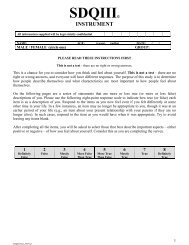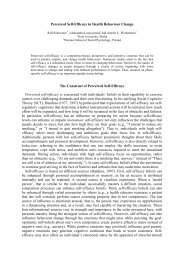Bodkin-Andrews, G, Craven, RG, and Martin AJ - SELF Research ...
Bodkin-Andrews, G, Craven, RG, and Martin AJ - SELF Research ...
Bodkin-Andrews, G, Craven, RG, and Martin AJ - SELF Research ...
Create successful ePaper yourself
Turn your PDF publications into a flip-book with our unique Google optimized e-Paper software.
Student Motivation Scale: <strong>Research</strong> findings.<br />
Testing of the SMES revealed that not only does the scale <strong>and</strong> its factor structure hold well against the rigours of<br />
confirmatory factory analysis <strong>and</strong> its fit indices, but such results remain consistent across invariance testing for gender,<br />
<strong>and</strong> three separate year groupings (junior, middle, <strong>and</strong> senior) within secondary school (<strong>Martin</strong>, 2004). More so, each<br />
adaptive factor was significantly <strong>and</strong> positively correlated with academic achievement, class participation, school<br />
enjoyment <strong>and</strong> future educational plans. For maladaptive factors, various relations were found with lower achievement<br />
measures, lower class participation, lower future educational plans <strong>and</strong> lower ratings of enjoyment of school. Impeding<br />
factors produced some negatively orientated correlations but mostly approached the near-zero correlation statistic. In a<br />
separate large-scale study utilizing the SMES, <strong>Martin</strong> (2003) found that for students with English as a second language,<br />
scores were significantly higher than students with English as a primary language for value of schooling, learning focus,<br />
planning <strong>and</strong> study management, yet significantly lower for perceived control. Although <strong>Martin</strong> (2003) rightfully calls<br />
for caution in interpreting these ambiguous results, they do suggest that the SMES is sensitive enough to identify<br />
differing response patterns across varying minority groups, thus providing a potentially promising instrument for<br />
assessing the motivational patterns of Indigenous Australian students.<br />
Recently, a longitudinal analysis was conducted on responses to the SMES before <strong>and</strong> after a youth enrichment<br />
program designed to enhance students’ abilities to focus on specific tasks, achieve a higher level of mastery, increase<br />
the positive nature of self-attitudes, develop a stronger sense of teamwork, cooperation, community, <strong>and</strong> peers relations<br />
(<strong>Martin</strong>, 2004b). In comparing the students that underwent this program with a separate, but comparable sample of<br />
students, <strong>Martin</strong>’s analysis found that although the intervention participants initially scored significantly lower in<br />
mastery orientation, planning <strong>and</strong> study management than the comparison group, eight weeks after the intervention,<br />
these differences were not only erased, but the intervention grouped scored significantly higher in self-efficacy, value of<br />
schooling, persistence, <strong>and</strong> significantly lower in uncertain control <strong>and</strong> self-sabotage when compared to the original<br />
comparison group. The implications of these findings suggest that numerous facets of the SMES may be successfully<br />
targeted by intervention strategies, <strong>and</strong> although no academic outcomes were measured in this study, adding the results<br />
of this study with <strong>Martin</strong>’s previous findings (2004a), it does indirectly suggest that student motivation may be<br />
enhanced to the extent that important educational outcomes may also be influenced in a positive manner. This could<br />
prove especially beneficial in identifying <strong>and</strong> correcting potential motivational differences between Indigenous <strong>and</strong> non-<br />
Indigenous students, hence lessoning the achievement gap between the two populations.<br />
Student Motivation: Indigenous Experience<br />
Although testing of the SMES is yet to be reported on responses by Indigenous participants, a smattering of other<br />
studies <strong>and</strong> theoretical research suggests that various facets of the SMES could prove to be revealing in examining some<br />
of the psychological mechanisms involved in the disadvantaged status of Indigenous Australian students (Boulton-<br />
Lewis, Wills & Lewis, 2003; Howard, 2003; <strong>Martin</strong>, 2003b; McInerney, 2003; McInerney, Etten & Dowson, 1998;<br />
Palmer, 2003; Parente, <strong>Craven</strong> & Munns, 2003) <strong>and</strong> other minority groups (Crocker & Major, 1989; Flowers, Milner &<br />
Moore III, 2003; Hwang, Echols & Vrongistinos, 2002; Murdock, 1999; Murray, 2002; Osborne, 1997).<br />
With regards to Indigenous Australian students, research directly examining the psychological mechanisms behind<br />
motivational patterns is scarce. A qualitative study of 52 Northern Territory high school students by Howard (2002)<br />
alluded to students having a lowered interest in the school system through the means of a problems with family support<br />
(see also <strong>Craven</strong> & Marsh, 2004; Parente et al., 2003), discrimination from peers <strong>and</strong> teachers <strong>and</strong> a lack of confidence.<br />
Burton-Lewis et al., (2003) conducted a small-scale, but detailed study qualitatively examining the study patterns of 15<br />
Indigenous Australian university students <strong>and</strong> they found patterns of dissonance between conceptions of learning <strong>and</strong><br />
ways of learning. That is, although Indigenous students did not differ from mainstream perceptions of the value of<br />
learning (e.g. mastery orientation), the majority of the Indigenous students interviewed used surface learning<br />
approaches of simple rehearsal rather than underst<strong>and</strong>ing, leading Boulton-Lewis <strong>and</strong> colleagues to conclude that<br />
Indigenous students need to be made aware of the value of “strategies that promote deeper engagement with<br />
information <strong>and</strong> more meaningful congruent perceptions of learning” (p. 87).<br />
One of the few authors to quantitatively examine the area of motivation within an Indigenous sample can be found<br />
in the work of McInerney <strong>and</strong> colleagues (McInerney, 2003; McInerney et al. 1998). In an early study examining the<br />
goal orientations of Indigenous Australian students, McInerney, et al., (1998) found that for a large sample of<br />
Indigenous students (n=496), immigrant students (n=487), <strong>and</strong> Anglo Australian students (n=1173) drawn from both<br />
rural <strong>and</strong> urban secondary schools, their motivational patterns were remarkably similar in that mastery orientations were<br />
considered to be the most conductive to academic performance by all students, significantly more so than performance<br />
<strong>and</strong> social motivation goals (although Indigenous students were significantly lower in mastery <strong>and</strong> performance scores<br />
when compared to both non-Indigenous groups). Of considerable importance is the finding that mastery orientation was<br />
the only indicator to significantly contribute to responses on value of school <strong>and</strong> further educational aspirations, even<br />
though Indigenous students performed significantly worse than the non-Indigenous students. These results in part saw<br />
McInerney et al. (1998, p. 626) conclude that despite similar adaptive motivational strategies, “Aboriginal students may<br />
have fewer experiences linking mastery <strong>and</strong> performance to school success”. The similarity between this conclusion <strong>and</strong><br />
that reached by Boulton-Lewis et al. (2003) in their qualitative study should not be ignored.<br />
That mastery orientation was the only significant motivational indicator on academic outcome variables is of<br />
considerable concern, <strong>and</strong> as McInerney (2003) suggests, this may indicated a lack of utility of positive motivational





